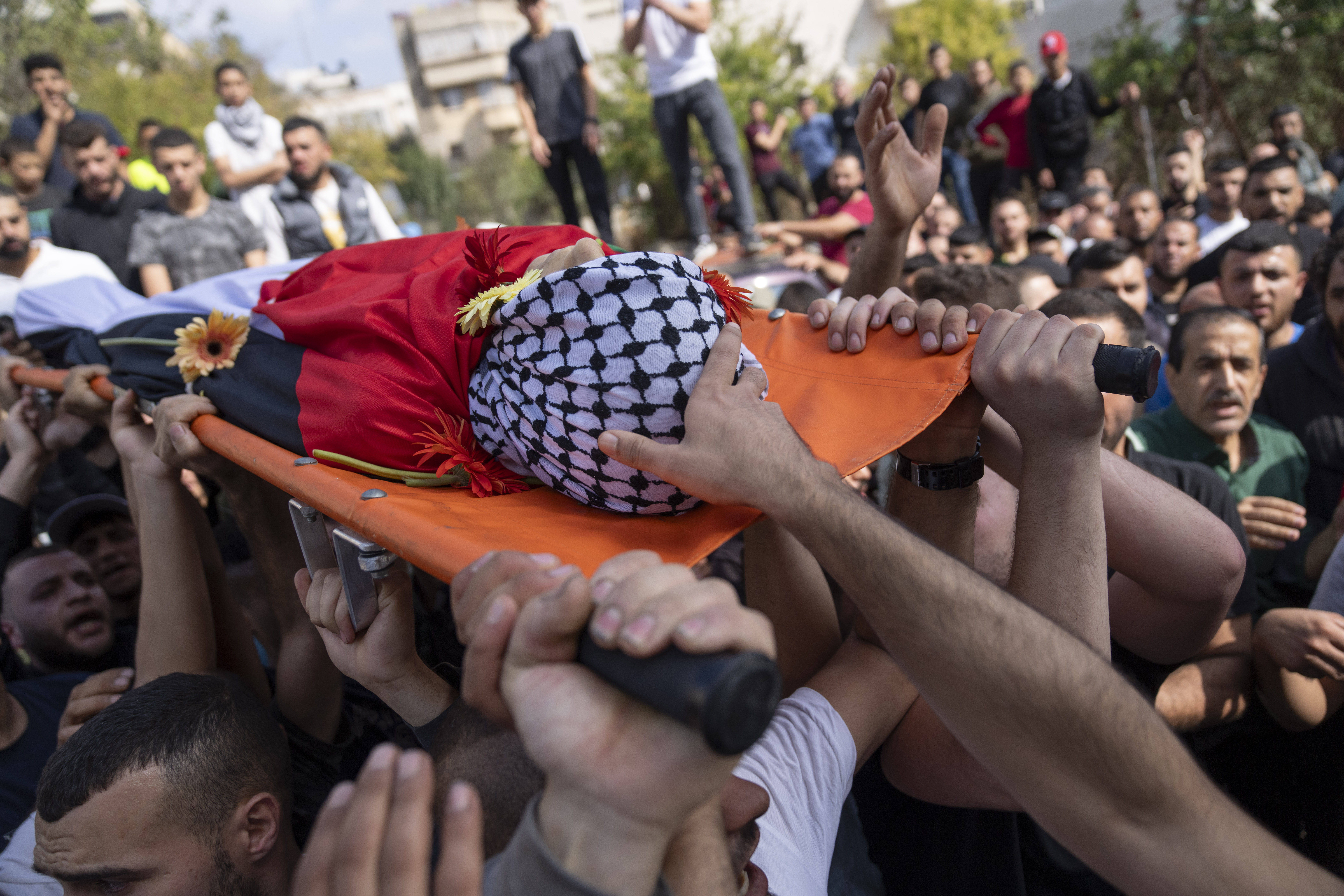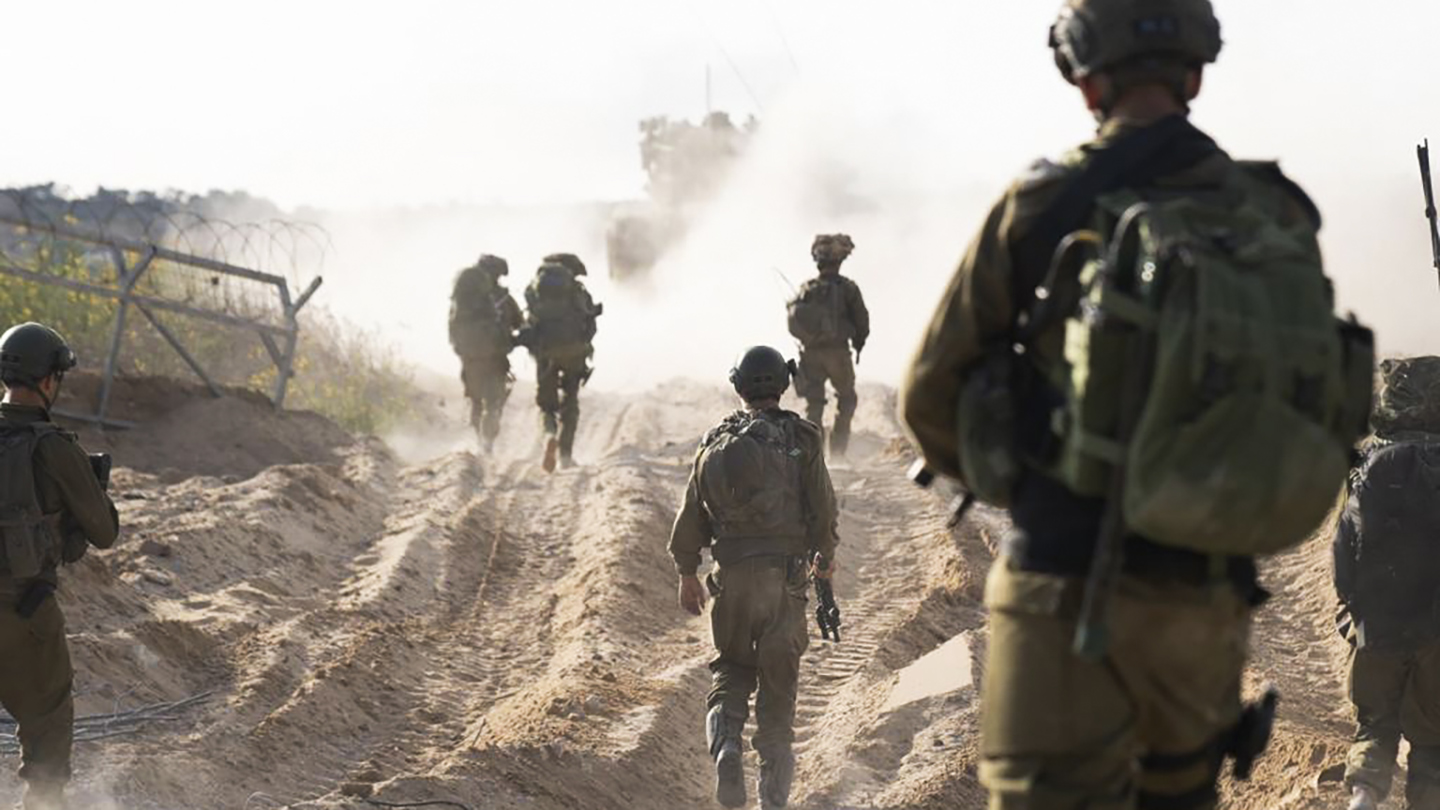The Israeli push into Gaza has effectively encircled Gaza City and isolated northern Gaza from the rest of the besieged Palestinian enclave, the United Nations said Thursday.
“Gaza City and northern Gaza have been ‘largely cut off’ from the rest of the strip as a result of the Israeli ground operations and related clashes with Palestinian armed groups,” according to the United Nations Office for the Coordination of Humanitarian Affairs (OCHA). “This means that the delivery of humanitarian aid from the south to some 300,000 internally displaced persons in the north has ‘come to a halt.’”
“For the last few days, IDF soldiers have been operating in Gaza City and are encircling it from several directions, increasing our entries, as well as our achievements,” Israel Defense Forces (IDF) Chief of Staff Lt. Gen. Herzi Halevi said in a statement Thursday.
“The soldiers are fighting in an urban, crowded and complex area that necessitates fighting in a very professional and courageous way. The ground forces are supported by precise intelligence, with supporting fire from the air and the sea. This partnership is our secret. It increases our achievements and make combat much more effective.”
You can read more about the challenges Israel will face in its Gaza invasion in our deep dive here.
The move to drive a wedge across Gaza separating the north from the south and enter Gaza City in force has been long anticipated as a major IDF objective. It’s designed to destroy at least part of the huge Hamas tunnel system known as the “Metro” and cut off escape and resupply routes.
Israeli troops are “conducting close combat battles with Hamas terrorists and expanding the fighting,” IDF spokesman Rear Adm. Daniel Hagari said during his Thursday morning briefing. “The soldiers continue to destroy Hamas’ defensive lines in northern Gaza and are working to secure central areas. We are continuing to intensify the activities and are advancing according to the plans and goals we set for ourselves.”
The fighting “was especially intense in several neighborhoods in northern Gaza, where Israeli troops attacked early Thursday in Karama and Zeitoun, moving closer to the center of Gaza City,” The Wall Street Journal reported.
“The soldiers engaged with the terrorists, with the assistance of artillery fire and tanks, while directing an aerial strike from a helicopter and a missile strike from a naval boat. Dozens of terrorists were killed during the battles,” according to the IDF. “The battle is advancing as we planned, in every battle we have the upper hand and this is how we will continue to advance.”
Hamas said on Telegram that it is putting up a fierce resistance and destroyed several Israeli armored vehicles, including a tank and an armored personnel carrier, with its locally produced Al-Yassin 105 anti-tank projectiles in northern Gaza.
At least 18 Israeli troops have been killed in the ground offensive, including 53 Battalion commander Lt. Col. Salman Habaka, who is the highest-ranking Israeli soldier to die in this war so far. To date, 332 Israeli troops have died since Oct. 7 the IDF said Thursday. The majority killed during the initial attack. The War Zone could not independently verify those figures or any others presented by either side in this war.
Meanwhile, the death toll for Palestinians continues to mount as the IDF carried out more strikes, including one on the Bureij refugee camp in central Gaza.
An air raid there Thursday “killed at least 15 people” at the camp, “home to some 46,000 Palestinian refugees who are registered with the United Nations Relief and Works Agency for Palestine Refugees (UNRWA),” Al Jazeera reported.
Rescue efforts pressed ahead on Thursday after two days of Israeli airstrikes decimated the densely populated Jabalia neighborhood of northern Gaza, The New York Times reported.
The Gazan health ministry said on Thursday that more than 1,000 people were killed, injured or missing after the strikes on Tuesday and Wednesday there.
A total of 9,061 people have been killed in Gaza since the start of the war, the Palestinian Health Ministry said in a statement today, NBC News reported. Among those killed are 3,760 children killed in Gaza and more than 2,300 women, the ministry said.
The IDF is also continuing attacks in the West Bank it says are aimed at rounding up Hamas terrorists there.
“The IDF, Shin Bet and MGB forces operated tonight in many centers throughout the Judea and Samaria Division and the Bekaa and Emekim Brigade to counter terrorism and confiscate weapons,” the IDF said Thursday. “The forces arrested 49 wanted persons suspected of involvement in terrorist activity, 21 of them terrorists belonging to the terrorist organization Hamas.”
During the arrests in Al Bira, “a disturbance developed that included throwing stones,” the IDF said. The IDF said it responded with gunfire.
The IDF said it also responded to gunfire at its troops in the West Bank town of Kalkiliya by opening fire there as well.
“So far, since the beginning of the war, over 1,220 wanted persons have been arrested throughout the Judea and Samaria Division and the Bekaa and Valleys Division, over 740 are associated with the terrorist organization Hamas.”
Palestinian officials said that a 14-year-old boy was killed during an Israeli raid near Ramallah in the West Bank.

Meanwhile, Israeli settlers appear to be continuing attacks on Palestinians in the West Bank.
“Experienced observers believe the spike in violence is part of a broader campaign to scare Palestinians off their land that has been allowed to accelerate amid Israel’s enraged and wounded mood,” The New York Times reported Thursday. “Since Oct. 7, settler violence has displaced more than 800 Palestinians, including entire herding communities.”
“The strategy is: We are here, this land belongs to us and we will kick you off it, with all the means we have,” said Dov Sedaka, a reserve Israeli general who works for a foundation that supports Israeli-Palestinian cooperation.
The Israel-Lebanon border remains a hot spot as the IDF and Hezbollah continue to trade attacks.
“Over the last hour, a number of launches from Lebanon toward Israeli territory were identified,” the IDF said on Telegram. “In response, the IDF is currently striking a series of Hezbollah terror targets in Lebanon.”
The targets struck by Israeli aircraft, tanks and artillery “include military infrastructure, command and control centers, rocket launching posts, weapons storage facilities and military compounds used by the Hezbollah terrorist organization.”
Hamas says that the rockets caused damaged in the northern Israeli city of Kiriyat Shemona. Imagery from the town supports that claim.

In the hours ahead of the highly anticipated first speech of this conflict by Hezbollah leader Hassan Nasrallah, the Lebanese militant group claimed an attack on Israeli forces at Shebaa Farms with two explosive-laden drones. That was the first time Hezbollah said it used those weapons in this conflict.
It is unclear yet whether Nasrallah will announce that he is planning to enter the war on behalf of Hamas or continue to maintain the current tempo of attacks that so far have been contained to the border region.
Should it decide to open up a new front, the well-armed, well-trained Hezbollah would pose a significant challenge, which you can read more about in our deep dive into its massive arsenal here.
In his media statement Thursday, Halevi, the IDF chief of staff, seemed to issue a veiled warning about any expansion of this war.
“But make no mistake – less than half of the total strength of the IAF is operating in the Gaza Strip! Most of the force is prepared and ready, with bombs on the wings and people who are ready to be scrambled at any moment to the planes, to go out and strike in other arenas as soon as required.”
“We are fighting in the name of the sanctity of life, against an enemy who has engraved death and destruction on their flag.”
In another ominous development on the northern front, the Russian Wagner mercenary group may provide an air defense system to Hezbollah, U.S. officials told The Wall Street Journal.
The system in question is the Pantsir-S1, also known by NATO nomenclature as the SA-22 Greyhound. It is a system Russian forces used last year to fire at a U.S. Reaper drone flying over Syria.
From our report about that incident: “It is a truck-mounted road-mobile air defense system armed with command-guided surface-to-air missiles and a pair of twin-barrel 30mm automatic cannons. It can use either its onboard radar and/or long-range infrared sensor to spot and track various threats. The system is primarily intended for lower-altitude point defense and is capable of engaging fixed-wing aircraft, helicopters, drones, cruise missiles, and other munitions, including reportedly artillery rockets.”
One U.S. official told the Journal that Washington hasn’t confirmed that the system has been sent. But U.S. officials are monitoring discussions involving Wagner and Hezbollah and that the potential delivery is a major concern. Wagner has personnel in Syria, where Hezbollah fighters have also been present.
There was more diplomatic fallout for Israel over its ongoing attacks on Gaza.
Bahrain’s parliament said on Thursday that the Gulf state’s ambassador to Israel had returned home and economic ties had been suspended in protest over the war in Gaza, Reuters reported.
The move, however, may be largely symbolic.
“The government did not confirm the moves, and Israel said it had received no word of any such actions, saying its relations with Bahrain were ‘stable,'” Reuters reported.
In its statement, the parliament – a consultative body with no powers in the area of foreign policy – said the moves “confirmed Bahrain’s historic position in support of the Palestinian cause.”
The announcement from Bahrain comes a day after Jordan also temporarily cut off diplomatic relations with Israel in protest.
Israel has acknowledged that its fleet of F-35I stealth fighters is playing an active role in the current Gaza conflict, announcing these jets were recently used to intercept and bring down a cruise missile. This was the first confirmation that an F-35I has been used to bring down a target of this kind. You can read more about this in our original reporting here.
As Israel has swatted down missiles and drones launched from Yemen this week, the Iranian-backed Houthi rebels there have declared war in a musical production number seen in this video below.
Nearly 200 Jordanians and at least six Americans were among those to have left Gaza through the Rafah crossing, a key border checkpoint between Egypt and Gaza, CNN reported.
As refugees leave Gaza and aid continues to flow in through the Rafah crossing, the U.K. Defense Ministry (MoD) said it flew forklifts, lighting towers and other equipment to Egypt needed to support humanitarian efforts there.
This is a developing story. We will update it when there is additional news about the Israel-Hamas war.
Contact the author: howard@thewarzone.com
